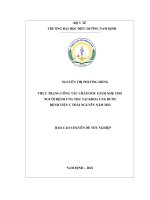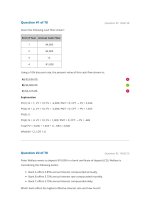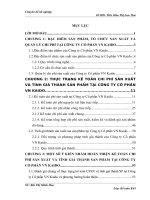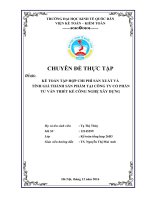x0002 2001 msdn c sharp essentials of object oriented programmin morebook vn 2582
Bạn đang xem bản rút gọn của tài liệu. Xem và tải ngay bản đầy đủ của tài liệu tại đây (1014.66 KB, 7 trang )
Module 7: Essentials of
Object-Oriented
Programming
Contents
Overview
1
Classes and Objects
Using Encapsulation
2
10
C# and Object Orientation
21
Lab 7: Creating and Using Classes
39
Defining Object-Oriented Systems
53
Review
62
This course is based on the prerelease Beta 1 version of Microsoft® Visual Studio .NET.
Content in the final release of the course may be different from the content included in
this prerelease version. All labs in the course are to be completed with the Beta 1
version of Visual Studio .NET.
Information in this document is subject to change without notice. The names of companies,
products, people, characters, and/or data mentioned herein are fictitious and are in no way intended
to represent any real individual, company, product, or event, unless otherwi se noted. Complying
with all applicable copyright laws is the responsibility of the user. No part of this document may
be reproduced or transmitted in any form or by any means, electronic or mechanical, for any
purpose, without the express written permission of Microsoft Corporation. If, however, your only
means of access is electronic, permission to print one copy is hereby granted.
Microsoft may have patents, patent applications, trademarks, copyrights, or other intellectual
property rights covering subject matter in this document. Except as expressly provided in any
written license agreement from Microsoft, the furnishing of this document does not give you any
license to these patents, trademarks, copyrights, or other intellectual property.
2001 Microsoft Corporation. All rights reserved.
Microsoft, ActiveX, BizTalk, IntelliSense, JScript, Microsoft Press, MSDN, PowerPoint, Visual
Basic, Visual C++, Visual C#, Visual Studio, Windows, and Windows Media are either registered
trademarks or trademarks of Microsoft Corporation in the U.S.A. and/or other countries.
Other product and company names mentioned herein may be the trademarks of their respective
owners.
Module 7: Essentials of Object-Oriented Programming
Overview
n
Classes and Objects
n
Using Encapsulation
n
C# and Object Orientation
n
Defining Object-Oriented Systems
C# is an object-oriented programming language. In this section, you will learn
the terminology and concepts required to create and use classes in C#.
After completing this module, you will be able to:
n
Define the terms object and class in the context of object-oriented
programming.
n
Define the three core aspects of an object: identity, state, and behavior.
n
Describe abstraction and how it helps you to create reusable classes that are
easy to maintain.
n
Use encapsulation to combine methods and data in a single class.
n
Explain the concepts of inheritance and polymorphism.
n
Create and use classes in C#.
1
2
Module 7: Essentials of Object-Oriented Programming
u Classes and Objects
n
What Is a Class?
n
What Is an Object?
n
Comparing Classes to Structs
n
Abstraction
The whole structure of C# is based on the object-oriented programming model.
To make the most effective use of C# as a language, you need to understand the
nature of object-oriented programming.
In this section, you will learn about the basics of object-oriented programming.
You will examine classes and objects in the context of object-oriented
programming. You will then learn the how to apply the concept of abstraction.
Module 7: Essentials of Object-Oriented Programming
3
What Is a Class?
CAR?
n
n
For the Philosopher…
l
An artefact of human classification!
l
Classify based on common behavior or attributes
l
Agree on descriptions and names of useful classes
l
Create vocabulary; we communicate; we think!
For the Object-Oriented Programmer…
l
A named syntactic construct that describes common
behavior and attributes
l
A data structure that includes both data and functions
The root word of classification is class. Forming classes is an act of
classification, and it is something that all human beings (not just programmers)
do. For example, all cars share common behavior (they can be steered, stopped,
and so on) and common attributes (they have four wheels, an engine, and so on).
You use the word car to refer to all of these common behaviors and properties.
Imagine what it would be like if you were not able to classify common
behaviors and properties into named concepts! Instead of saying car, you would
have to say all the things that car means. Sentences would be long and
cumbersome. In fact, communication would probably not be possible at all. As
long as everyone agrees what a word means, that is, as long as we all speak the
same language, communication works well— we can express complex but
precise ideas in a compact form. We then use these named concepts to form
higher-level concepts and to increase the expressive power of communication.
All programming languages can describe common data and common functions.
This ability to describe common features helps to avoid duplication. A key
motto in programming is “Don’t repeat yourself.”Duplicate code is
troublesome because it is more difficult to maintain. Code that does not repeat
itself is easier to maintain, partly because there is just less of it! Object-oriented
languages take this concept to the next level by allowing descriptions of classes
(sets of objects) that share structure and behavior. If done properly, this
paradigm works extremely well and fits naturally into the way people think and
communicate.
Classes are not restricted to classifying concrete objects (such as cars); they can
also be used to classify abstract concepts (such as time). However, when you
are classifying abstract concepts, the boundaries are less clear, and good design
becomes more important.
The only real requirement for a class is that it helps people communicate.
Module 7: Essentials of Object-Oriented Programming
3. Describe inheritance in the context of object-oriented programming.
4. What is polymorphism? How is it related to early and late binding?
5. Describe the differences between interfaces, abstract classes, and concrete
classes.
63
THIS PAGE INTENTIONALLY LEFT BLANK









